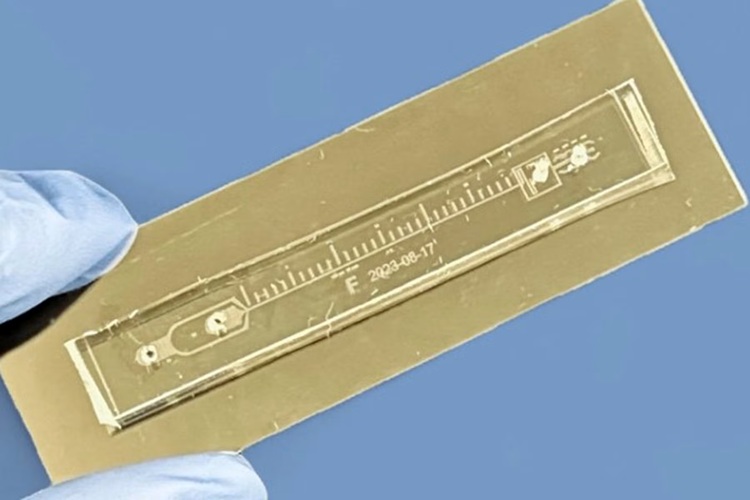Novel Test May Enable Quick Reliable Detection of Sepsis
|
By LabMedica International staff writers Posted on 20 Jun 2016 |

Image: In the new pathogen-detection technology, engineered FcMBL proteins coupled to magnetic beads (grey) specifically bind to carbohydrate molecules on the surface of pathogens, like infectious E. coli (blue) in this electron micrograph, or on fragments of dead pathogens circulating in the bloodstream. After isolation in a magnetic field, the total pathogenic material is quantified with a second FcMBL protein linked to a color-producing enzyme (Photo courtesy of Wyss Institute at Harvard University).
Researchers have developed a rapid specific diagnostic assay that could help physicians decide within an hour whether a patient has a systemic infection. Its potential to detect pathogen materials was demonstrated in animal studies and a prospective human clinical study, whose results also suggested that it could also serve as a companion diagnostic to monitor antibiotic and dialysis-like sepsis therapies.
The current standard-of-care for detecting blood-borne infections is blood culture, but this takes days, only identifies pathogens in less than 30% of patients with fulminant infections, and is not able to detect toxic fragments of dead pathogens that also drive the exaggerated inflammatory reactions leading to sepsis. Biomarkers that report elevated inflammation are used to monitor treatment of patients with sepsis, but they fail to distinguish inflammation triggered by infectious pathogens from that induced by non-infectious causes (e.g. burns, traumas, surgeries).
The assay was developed and tested by a research team from Wyss Institute for Biologically Inspired Engineering at Harvard University (Boston, MA, USA) led by Donald Ingber, MD, PhD, Wyss Institute’s founding director, and professor at Harvard Medical School and Boston Children’s Hospital: "Our pathogen detection technology solves both dilemmas: it quickly reports whether infectious pathogens are present in the body, even at early stages of infection before sepsis develops; And it can more specifically identify patients who have excessive inflammation due to systemic infection, rather than other causes," said Prof. Ingber, "This assay could become a real game changer in this clinical area, and it also should lead to more judicious use of antibiotics."
"In a cohort of emergency room patients with suspected sepsis, we saw that the assay picked up infection within an hour in 85% of patients who exhibited clinical symptoms of sepsis, and equally importantly it did not falsely predict infection in healthy subjects or patients with inflammation triggered by other causes, such as trauma. On the other hand, blood cultures that we performed in parallel using the same samples only detected pathogens in 18% of the cases," said Nathan Shapiro, MD, PhD, director, Translational Research, Center for Vascular Biology Research at BIDMC, who worked with the team.
The assay technology is based on magnetic beads to FcMBL, a genetically engineered pathogen-binding protein previously developed by Prof. Ingber and Michael Super, a Wyss senior staff scientist who co-leads the pathogen-detection effort. By recognizing surface carbohydrate molecules, FcMBL binds to pathogens and pathogen-released fragments – pathogen-associated molecular patterns (PAMPs). The team previously established FcMBL as a key component of an advanced dialysis-like, pathogen-extracting therapeutic device, and of a method for fast retrieval of infectious pathogens from complex clinical samples to enable identification and antibody susceptibilities.
"In our latest work, we show that the FcMBL-based pathogen-detecting assay is considerably faster and more accurate than any other available assay for systemic infection. We are currently working to ready it for high-throughput use in clinical and point-of-care situations," said co-lead-author Mark Cartwright, PhD, staff scientist at Wyss.
As a prerequisite to their clinical study, the team had successfully tested the assay in rat and pig models infected with pathogenic E. coli. "The animal models clearly told us that the assay can sensitively trace spikes of PAMPs released during antibiotic therapy, or residual infectious PAMP materials, even when no living bacteria circulate anymore in blood but they remain hidden inside internal organs. Thus, this assay could be an excellent tool for monitoring ongoing infection and responses to antibiotics and dialysis-like therapies for severe infections and sepsis," said Mike Super, PhD.
The findings suggest that this technology, with its rapid handling time, high sensitivity and broad specificity, could provide a real advance for diagnosing infections in clinical microbiology laboratories and point-of-care settings.
The study, by Cartwright M et al, was published online June 12, 2016, in the journal eBioMedicine.
Related Links:
Wyss Institute
The current standard-of-care for detecting blood-borne infections is blood culture, but this takes days, only identifies pathogens in less than 30% of patients with fulminant infections, and is not able to detect toxic fragments of dead pathogens that also drive the exaggerated inflammatory reactions leading to sepsis. Biomarkers that report elevated inflammation are used to monitor treatment of patients with sepsis, but they fail to distinguish inflammation triggered by infectious pathogens from that induced by non-infectious causes (e.g. burns, traumas, surgeries).
The assay was developed and tested by a research team from Wyss Institute for Biologically Inspired Engineering at Harvard University (Boston, MA, USA) led by Donald Ingber, MD, PhD, Wyss Institute’s founding director, and professor at Harvard Medical School and Boston Children’s Hospital: "Our pathogen detection technology solves both dilemmas: it quickly reports whether infectious pathogens are present in the body, even at early stages of infection before sepsis develops; And it can more specifically identify patients who have excessive inflammation due to systemic infection, rather than other causes," said Prof. Ingber, "This assay could become a real game changer in this clinical area, and it also should lead to more judicious use of antibiotics."
"In a cohort of emergency room patients with suspected sepsis, we saw that the assay picked up infection within an hour in 85% of patients who exhibited clinical symptoms of sepsis, and equally importantly it did not falsely predict infection in healthy subjects or patients with inflammation triggered by other causes, such as trauma. On the other hand, blood cultures that we performed in parallel using the same samples only detected pathogens in 18% of the cases," said Nathan Shapiro, MD, PhD, director, Translational Research, Center for Vascular Biology Research at BIDMC, who worked with the team.
The assay technology is based on magnetic beads to FcMBL, a genetically engineered pathogen-binding protein previously developed by Prof. Ingber and Michael Super, a Wyss senior staff scientist who co-leads the pathogen-detection effort. By recognizing surface carbohydrate molecules, FcMBL binds to pathogens and pathogen-released fragments – pathogen-associated molecular patterns (PAMPs). The team previously established FcMBL as a key component of an advanced dialysis-like, pathogen-extracting therapeutic device, and of a method for fast retrieval of infectious pathogens from complex clinical samples to enable identification and antibody susceptibilities.
"In our latest work, we show that the FcMBL-based pathogen-detecting assay is considerably faster and more accurate than any other available assay for systemic infection. We are currently working to ready it for high-throughput use in clinical and point-of-care situations," said co-lead-author Mark Cartwright, PhD, staff scientist at Wyss.
As a prerequisite to their clinical study, the team had successfully tested the assay in rat and pig models infected with pathogenic E. coli. "The animal models clearly told us that the assay can sensitively trace spikes of PAMPs released during antibiotic therapy, or residual infectious PAMP materials, even when no living bacteria circulate anymore in blood but they remain hidden inside internal organs. Thus, this assay could be an excellent tool for monitoring ongoing infection and responses to antibiotics and dialysis-like therapies for severe infections and sepsis," said Mike Super, PhD.
The findings suggest that this technology, with its rapid handling time, high sensitivity and broad specificity, could provide a real advance for diagnosing infections in clinical microbiology laboratories and point-of-care settings.
The study, by Cartwright M et al, was published online June 12, 2016, in the journal eBioMedicine.
Related Links:
Wyss Institute
Latest Microbiology News
- Rapid Assay Identifies Bloodstream Infection Pathogens Directly from Patient Samples
- Blood-Based Molecular Signatures to Enable Rapid EPTB Diagnosis
- 15-Minute Blood Test Diagnoses Life-Threatening Infections in Children
- High-Throughput Enteric Panels Detect Multiple GI Bacterial Infections from Single Stool Swab Sample
- Fast Noninvasive Bedside Test Uses Sugar Fingerprint to Detect Fungal Infections
- Rapid Sepsis Diagnostic Device to Enable Personalized Critical Care for ICU Patients
- Microfluidic Platform Assesses Neutrophil Function in Sepsis Patients
- New Diagnostic Method Confirms Sepsis Infections Earlier
- New Markers Could Predict Risk of Severe Chlamydia Infection
- Portable Spectroscopy Rapidly and Noninvasively Detects Bacterial Species in Vaginal Fluid
- CRISPR-Based Saliva Test Detects Tuberculosis Directly from Sputum
- Urine-Based Assay Diagnoses Common Lung Infection in Immunocompromised People
- Saliva Test Detects Implant-Related Microbial Risks
- New Platform Leverages AI and Quantum Computing to Predict Salmonella Antimicrobial Resistance
- Early Detection of Gut Microbiota Metabolite Linked to Atherosclerosis Could Revolutionize Diagnosis
- Viral Load Tests Can Help Predict Mpox Severity
Channels
Clinical Chemistry
view channel
Chemical Imaging Probe Could Track and Treat Prostate Cancer
Prostate cancer remains a leading cause of illness and death among men, with many patients eventually developing resistance to standard hormone-blocking therapies. These drugs often lose effectiveness... Read more
Mismatch Between Two Common Kidney Function Tests Indicates Serious Health Problems
Creatinine has long been the standard for measuring kidney filtration, while cystatin C — a protein produced by all human cells — has been recommended as a complementary marker because it is influenced... Read moreMolecular Diagnostics
view channel
New Genetic Test Enables Faster Diagnosis of Rare Diseases
Rare disease diagnosis often involves a long and uncertain search for the underlying genetic cause. Traditional testing requires multiple separate analyses, although many patients remain without answers.... Read more
Urine Test Detects Inherited Neuropathy Missed by Genetic Screening
Sorbitol dehydrogenase (SORD)-related neuropathy is one of the most common inherited nerve disorders, yet diagnosis often lags because current genetic screens frequently miss the causal gene.... Read moreHematology
view channel
Platelet Activity Blood Test in Middle Age Could Identify Early Alzheimer’s Risk
Early detection of Alzheimer’s disease remains one of the biggest unmet needs in neurology, particularly because the biological changes underlying the disorder begin decades before memory symptoms appear.... Read more
Microvesicles Measurement Could Detect Vascular Injury in Sickle Cell Disease Patients
Assessing disease severity in sickle cell disease (SCD) remains challenging, especially when trying to predict hemolysis, vascular injury, and risk of complications such as vaso-occlusive crises.... Read more
ADLM’s New Coagulation Testing Guidance to Improve Care for Patients on Blood Thinners
Direct oral anticoagulants (DOACs) are one of the most common types of blood thinners. Patients take them to prevent a host of complications that could arise from blood clotting, including stroke, deep... Read moreImmunology
view channel
Chip Captures Cancer Cells from Blood to Help Select Right Breast Cancer Treatment
Ductal carcinoma in situ (DCIS) accounts for about a quarter of all breast cancer cases and generally carries a good prognosis. This non-invasive form of the disease may or may not become life-threatening.... Read more
Blood-Based Liquid Biopsy Model Analyzes Immunotherapy Effectiveness
Immunotherapy has revolutionized cancer care by harnessing the immune system to fight tumors, yet predicting who will benefit remains a major challenge. Many patients undergo costly and taxing treatment... Read morePathology
view channel
Blood Test and Sputum Analysis Predict Acute COPD Exacerbation
Chronic obstructive pulmonary disease (COPD) remains a major contributor to global illness, largely driven by cigarette smoking and marked by irreversible lung damage. Acute exacerbations can accelerate... Read more
AI Tool to Transform Skin Cancer Detection with Near-Perfect Accuracy
Melanoma continues to be one of the most difficult skin cancers to diagnose because it often resembles harmless moles or benign lesions. Traditional AI tools depend heavily on dermoscopic images alone,... Read more
Unique Immune Signatures Distinguish Rare Autoimmune Condition from Multiple Sclerosis
Myelin oligodendrocyte glycoprotein antibody–associated disease (MOGAD) is a rare autoimmune disorder in which the immune system attacks the myelin sheath in the central nervous system. Although symptoms... Read moreTechnology
view channel
AI Saliva Sensor Enables Early Detection of Head and Neck Cancer
Early detection of head and neck cancer remains difficult because the disease produces few or no symptoms in its earliest stages, and lesions often lie deep within the head or neck, where biopsy or endoscopy... Read more
AI-Powered Biosensor Technology to Enable Breath Test for Lung Cancer Detection
Detecting lung cancer early remains one of the biggest challenges in oncology, largely because current tools are invasive, expensive, or unable to identify the disease in its earliest phases.... Read moreIndustry
view channel
Abbott Acquires Cancer-Screening Company Exact Sciences
Abbott (Abbott Park, IL, USA) has entered into a definitive agreement to acquire Exact Sciences (Madison, WI, USA), enabling it to enter and lead in fast-growing cancer diagnostics segments.... Read more




 assay.jpg)





 Analyzer.jpg)













